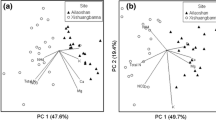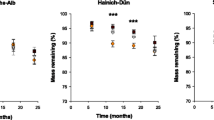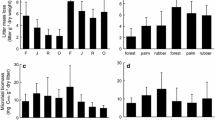Summary
Leaf litter decomposition, levels of accumulated litter as well as the abundance and biomass of earthworms were measured in three mature beech forests in southern Sweden: one mor site, one poor mull site, and one rich mull site. The disappearance rate of beech litter, measured with litter bags, increased with increasing soil fertility. On the rich mull site, the disappearance rate was much higher than in the two other forests, due to the combined effects of higher earthworm activity, more favouable soil moisture conditions, and higher litter quality. Incubating the litter in finely meshed bags (1-mm mesh) to exclude macrofauna had a great effect on litter mass loss in the rich mull site, but it had only a minor effect in the other sites. Simultaneous incubations of local and transplanted leaf litter on the three study sites showed that the substrate quality of the litter increased in the order: mor site — poor mull site — rich mull site. Lignin, N, and P concentrations of the leaf litter failed to explain the observed differences in decomposition rates, and acid/base properties are suggested to be more important. Earthworm numbers per m2 were 2.5 (1 species) in the mor, 40 (6 species) in the poor mull and 220 (9 species) in the rich mull forest. Soil chemical conditions, notably pH, were suggested as the main factors determining the inter-site differences in abundance and species composition of earthworms. The role of litter decomposition and earthworm activity in the accumulation of organic matter in the forest floor in different types of beech woodlands are discussed.
Similar content being viewed by others
References
Anderson JM (1973) The breakdown and decomposition of Sweet Chestnut (Castanea sativa Mill.) and beech (Fagus sylvatica L.) leaf litter in two deciduous woodland soils. I. Breakdown, leaching and decomposition. Oecologia (Berlin) 12:251–274
Berg B, Staaf H (1980) Decomposition rate and chemical changes of Scots pine needle litte. II. Influence of chemical composition. In: Persson T (ed) Structure and function of northern coniferous forests — An ecosystem study. Ecol Bull (Stockholm) 32:373–390
Bethge PO, Rådeström R, Theander O (1971) Kvantitativ kolhydratbestämning — en detaljstudie. Comm. Swedish Forest Product Research Lab. (Stockholm) 63B (In Swedish)
Bocock KL, Gilbert OJW (1975) The disappearance of leaf litter under different woodland conditions. Plant and Soil 9:179–185
Bocock KL, Gilbert O, Capstick CK, Twinn DC, Wai JS, Woodman MJ (1960) Changes in leaf litter when placed on the surface of soils with contrasting humus types. J Soil Sci 11:1–9
Bornebusch CH (1930) The fauna of foret soil. Det Forstlige Forsøgsvaesen i Danmark 11:1–158
Coulson CB, Davies RI, Lewis DA (1960) Polyphenols in plants, humus, and soil. I. Polyphenols in leaves, litter, and superficial humus from mull and mor sites. J Soil Sci 11:20–29
Cuendet G (1984) A comparative study of the carthworm population of four different woodland types in Wytham woods, Oxford. Pedobiologia 26:421–439
Davies RI, Coulson CB, Lewis DA (1964) Polyphenols in plants, humus, and soil. III. Stabilization of gelatin by polyphenol tanning. J Soil Sci 15:299–309
Easton EG (1983) A guide to the valid names of Lumbricidae (Oligochaeta). In: Satchell JE (ed) Earthworm ecology. Chapman and Hall, London, pp 475–485
Fogel R, Cromack K Jr (1977) Effect of habitat and substrate quality on Douglas fir litter decomposition in western Oregon. Can J Bot 55:1632–1640
Hagerman AE, Butler LG (1978) Protein precipitation method for the quantitative determination of tannin. J Agric Food Chem 26:809–812
Heath GW, Arnold MK (1966) Studies in leaf-litter breakdown. II. Breakdown of “sun” and “shade” leaves. Pedobiologia 6:238–243
Herlizius R, Herlizius H (1977) Streuabbau in Läubwäldern. Untersuchungen in Kalk-und Sauerhumusbuchenwäldern. Oecologia (Berlin) 30:147–171
John MK (1970) Colorimetric determination of phosphorus in soil and plant material with ascorbic acid. Soil Sci 109:214–220
Laverack MS (1961) Tactile and chemical perception in earthworms — II responses to acid pH solutions. Comp Biochem Physiol 2:22–34
Lindgren L (1970) Beech forest vegetation in Sweden, a survey. Bot Not 123:401–424
Lindquist B (1938) Ein Laubwald in Schonen in der Vergangenheit und Gegenwart. Acta Phytogegr Suec 10, Stockholm (In Swedish, with German summary)
Lindquist B (1941) Untersuchungen über die Bedeutung einiger skandinavischer Regenwürmer für die Zersetung der Laubstreu und für die Struktur der Mullerde. Sv Skogsvårdsför Tidskr 39:179–242 (In Swedish, with German summary)
Melillo JM, Aber JD, Muratore JF (1982) Nitrogen and lignin control of hardwood leaf litter decomposition dynamics. Ecology 63:621–626
Mommaerts-Billiet F (1971) Aspects dynamiques de la disparition de la litère de feuilles. Bull Soc Roy Bot Belg 104:181–195
Nihlgård B, Lindgren L (1977) Plant biomass, primary production and bioelements of three mature beech forests in South Sweden. Oikos 28:95–104
Nordström S, Rudgren S (1973) Associations of lumbricids in southern Sweden. Pedobiologia 13:301–326
Nordström S, Rundgren S (1974). Environmental factors and lumbricid associations in southern Sweden. Pedobiologia 14:1–27
Olson JS (1963) Energy storage and the balance of producers and decomposers in ecological systems. Ecology 44:322–331
Phillipson J, Abel R, Steel J, Woodell SRJ (1976) Earthworms and the factors govering their distribution in an English beechwood. Pedobiologia 16:258–285
Phillipson J, Abel R, Steel J, Woodell SRJ (1978) Earthworm numbers, biomass and respiratory metabolism in a beech woodland — Wytham Woods, Oxford. Oecologia (Berlin) 33:291–309
Rabeler W (1960) Die Artenbestäde der Regenwürmer in Laub-Biozönosen (Querce-Fageta) des oberen und mittleren Wesergebietes. Mitt Florist Soz Arbeitsgem N.F. 8:333–337
Raw F (1959) Estimating earthworm populations by using formalin. Nature (London) 184:1661–1662
Raw F (1962) Studies of earthworm popultions in orchards. I. Leaf burial in apple orchards. Ann Appl Biol 50:389–404
Satchell JE (1967) Lumbricidae. In: Burges A, Raw F (eds) Soil biology. Academic Press, London, pp 259–322
Satchell JE, Lowe DG (1967) Selection of leaf litter by lumbricids. In: Graff O, Satchell JE (eds) Progress in soil biology. North Holland Publ Comp, Amsterdam, pp 102–119
Staaf H (1980) Influence of chemical composition, additoon of raspherry leaves, and nitrogen supply on decomposition rate and dynamics of nitrogen and phosphorus in beech leaf litter. Oikos 35:55–62
Wittich W (1943) Untersuchungen über den Verlauf der Streuzersetzungen auf einem Boden mit Mullzustand II. Forstarch 19:1–18
Wittich W (1953) Untersuchungen über den Verlauf der Streuzersetzung auf einem Boden mit starker Regenwurmtätigkeit. Schriftenreihe der Forstl. Fakultät Göttingen 9:4–33
Zajonc I (1971) La distribution quatitative des lombrics (Lumbricidae ologochaeta) dans les grands types mondiaux d'écosystèmes forestiers. In: Duvigneaud P (ed) Productivity of forest ecosystems. UNESCO, Paris, pp 453–462
Author information
Authors and Affiliations
Rights and permissions
About this article
Cite this article
Staaf, H. Foliage litter turnover and earthworm populations in three beech forests of contrasting soil and vegetation types. Oecologia 72, 58–64 (1987). https://doi.org/10.1007/BF00385045
Received:
Issue Date:
DOI: https://doi.org/10.1007/BF00385045




